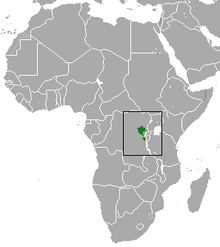- Eastern gorilla
-
Eastern gorilla[1] 
Conservation status Scientific classification Kingdom: Animalia Phylum: Chordata Class: Mammalia Order: Primates Family: Hominidae Genus: Gorilla Species: G. beringei Binomial name Gorilla beringei
Matschie, 1903Subspecies 
Eastern gorilla range The eastern gorilla (Gorilla beringei) is a species of the genus Gorilla and the largest living primate. At present, the species is subdivided into two subspecies. The eastern lowland gorilla (G. b. graueri) is the most populous, at about 5,000 individuals.[3] The mountain gorilla (G. b. beringei) has only about 700 individuals. In addition, scientists are considering elevating the Bwindi gorilla population (which numbers about half of the mountain gorilla population) to the rank of subspecies.
Contents
Classification
There are at least two subspecies of the eastern gorilla: the mountain gorilla (Gorilla beringei beringei) of the volcanic slopes of Rwanda, Uganda and eastern Democratic Republic of Congo; and the eastern lowland gorilla (Gorilla beringei graueri) of the lowlands of eastern Democratic Republic of Congo and Uganda. A small population from the Bwindi Impenetrable Forest in southern Uganda and adjacent areas in Congo differs genetically from the other subspecies, and is therefore often considered as a separate, yet undescribed, subspecies.
The eastern lowland gorilla and mountain gorilla were previously thought to be two of the three subspecies of one single species, the gorilla (Gorilla gorilla). However, genetic research has shown that the two eastern subspecies are far more closely related than the western subspecies: the western lowland gorilla (G. gorilla gorilla), which justified the separate classification.[citation needed] The two eastern subspecies are now classified as G. beringei.
Physical characteristics
The eastern gorilla is a large hominid with a large head, broad chest, and long arms. It has a flat nose with large nostrils. The face, hands, feet and breast are bald. The fur is mainly black, but adult males have a silvery "saddle" on their back. When the gorilla gets older, the entire fur becomes grayish, much like the gray hair of elderly people. This is why the older males are sometimes called Silverbacks. The eastern lowland gorilla has a shorter, thicker, deep black fur, while the mountain gorilla has a more bluish color. The mountain gorilla is slightly smaller and lighter than the eastern lowland gorilla, but still slightly larger than the western lowland gorilla. Males are much larger than females. A full-grown adult male Eastern gorilla weighs an average of 195 kg (430 lb) and stands 1.7 m (5.6 ft) upright and a female typically weighs 100 kg (220 lb) and stands 1.4 m (4.6 ft).[4] The tallest silverback recorded was a 1.94-metre (6.4 ft) individual shot in Alimbongo, northern Kivu in May 1938. The heaviest gorilla recorded was a 1.83-metre (6.0 ft) silverback shot in Ambam, Cameroon which weighed about 266 kilograms (590 lb),[5] although the latter area is within the range of the western gorilla, far outside that of the eastern gorilla.
Distribution and ecology
The eastern gorilla occurs in the lowland and mountain rainforests and subalpine forests of eastern Democratic Republic of the Congo, southwestern Uganda and Rwanda, within the triangle between the Lualaba River, Lake Edward and Lake Tanganyika. The eastern gorilla prefers forests with a substrate of dense plant material.
Eastern gorillas are herbivorous, with a heavily foliage based diet . They have smaller home ranges than western gorillas as foliage is more abundant than fruit. They are diurnal but the majority of foraging occurs in the morning and late afternoon. At night they build nests by folding over vegetation, usually on the ground.
Behavior
Eastern gorillas live in stable, cohesive family groups, led by a dominant silverback male. Eastern gorillas tend to have larger group sizes than their western relatives, numbering up to 35 individuals. There is no distinct breeding season and females give birth only once every 3-4 years due to the long period of parental care and a gestation period of 8.5 months. Newborn gorillas have greyish-pink skin and can crawl after 9 weeks; they are not fully weaned until 3.5 years. Males defend their females and offspring using their large size in intimidating displays involving charging and chest-beating.
Status
The eastern gorilla is the more critically endangered of the two gorilla species. The hunt for bushmeat and the decline in suitable habitat as a result of intensifying forestry and the development of agriculture form the most important threats for the species. In some national parks, expeditions in search for mountain gorillas are a popular tourist attraction. This has both advantages (environmental awareness, financial benefit) and disadvantages (disturbance of natural behavior) for the conservation of the gorillas.[citation needed]
As opposed to the western lowland gorilla, the eastern gorilla is seldom found in zoos. The Antwerp Zoo is probably the only Western zoo that has eastern lowland gorillas (two older females). The mountain gorilla is not held in captivity at all.[6]
References
- ^ Groves, C. (2005). Wilson, D. E., & Reeder, D. M, eds. ed. Mammal Species of the World (3rd ed.). Baltimore: Johns Hopkins University Press. pp. 181-182. OCLC 62265494. ISBN 0-801-88221-4. http://www.bucknell.edu/msw3/browse.asp?id=12100788.
- ^ Robbins, M. & Williamson, L. (2008). Gorilla beringei. In: IUCN 2008. IUCN Red List of Threatened Species. Downloaded on 4 January 2009.
- ^ "Gorillas on Thin Ice". United Nations Environment Programme. 15 January 2009. http://www.unep.org/Documents.Multilingual/Default.asp?DocumentID=556&ArticleID=6033&l=en&t=long. Retrieved 19 May 2010.: "The Eastern Lowland Gorilla population in the DRC has plummeted dramatically over the last 10 years, with probably only about 5,000 of the formerly 17,000 animals remaining."
- ^ Caldecott, Julian; Miles, Lera (2005). World Atlas of Great Apes and Their Conservation. University of California Press. ISBN 0-520-24633-0.
- ^ Wood, The Guinness Book of Animal Facts and Feats. Sterling Pub Co Inc (1983), ISBN 978-0851122359
- ^ Fossey, Dian (2000). Gorillas in the Mist. Houghton Mifflin Books. ISBN 0-618-08360-X.
External links
Extant species of family Hominidae (Great apes) Kingdom: Animalia · Phylum: Chordata · Class: Mammalia · Order: Primates · Suborder: Haplorrhini Ponginae Homininae Western Gorilla (G. gorilla) · Eastern Gorilla (G. beringei)Category Ape-related articles Ape species 
Ape study Ape language · Ape Trust · Dian Fossey · Birutė Galdikas · Jane Goodall · Chimpanzee genome project · Human genome project · Neanderthal genome project · Willie Smits · Lone Drøscher Nielsen · Borneo Orangutan SurvivalLegal and social status See also Bushmeat · Ape extinction · List of notable apes · List of fictional apes · Human evolution · Mythic humanoids · HominidCategories:- IUCN Red List endangered species
- Gorillas
- Animals described in 1903
- Mammals of the Democratic Republic of the Congo
- Mammals of Rwanda
- Mammals of Uganda
Wikimedia Foundation. 2010.

